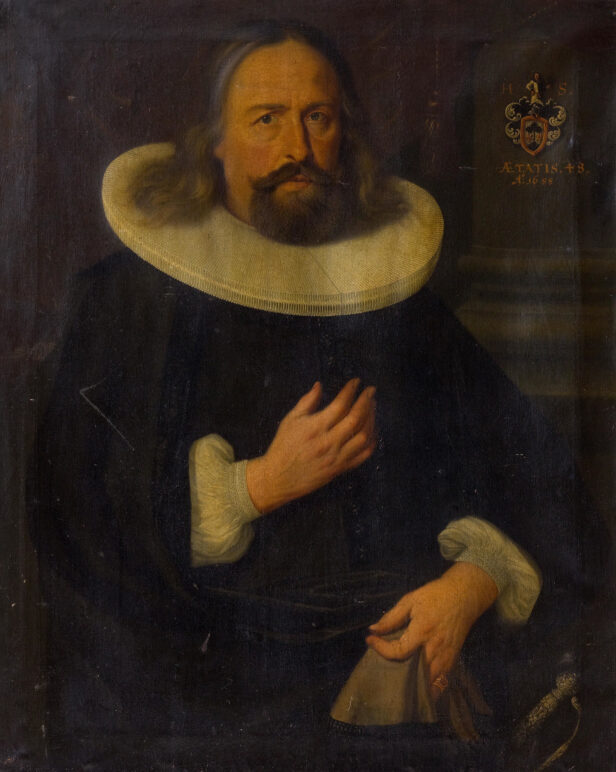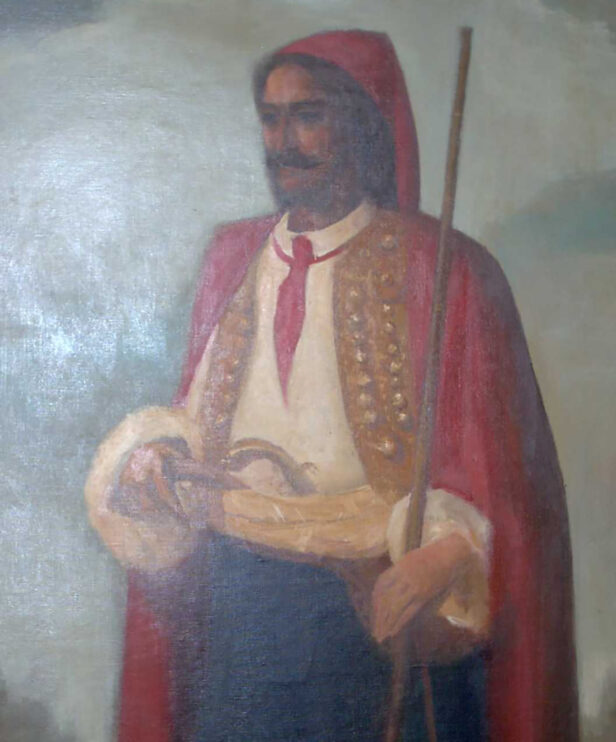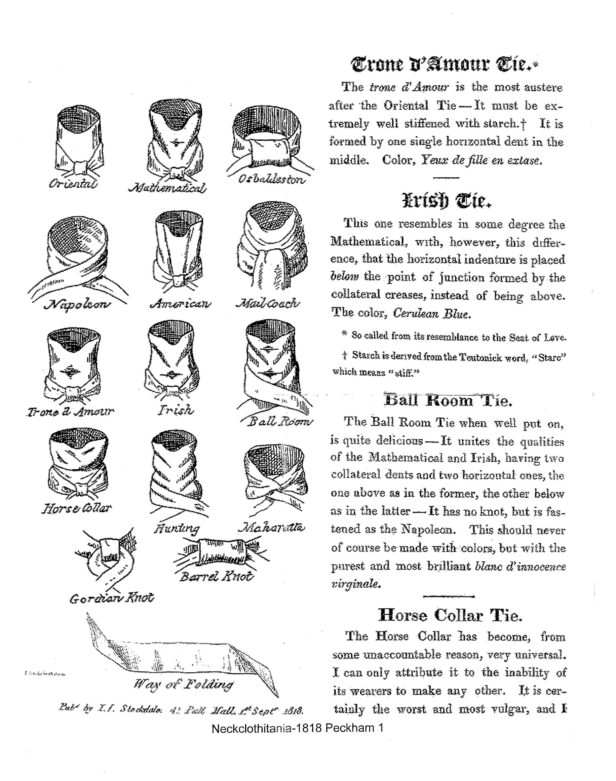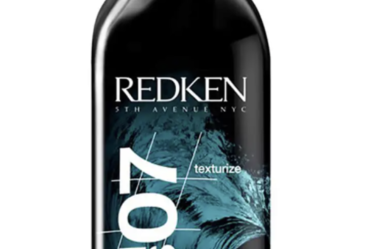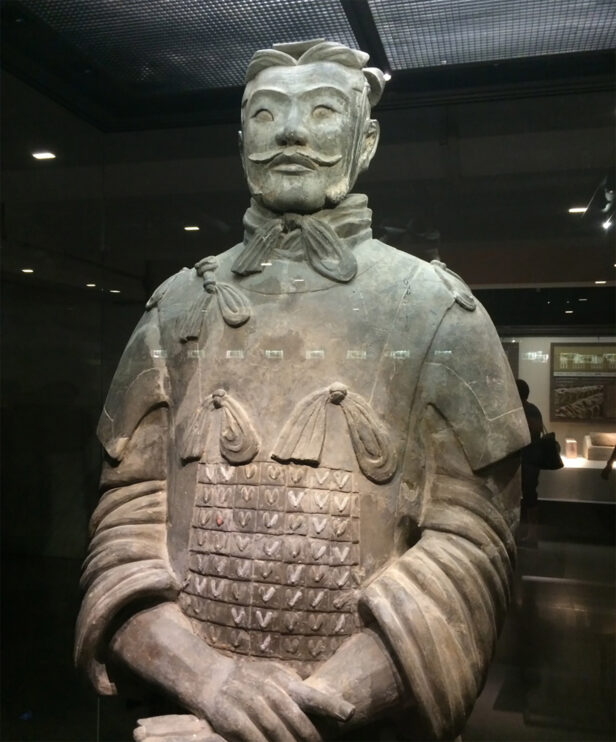
T
The necktie. One article of men’s clothing commonly worn today, though not as common as it once was, that arguably serves no functional purpose.
The modern necktie is today largely decorative, but it has not always been purely an article of fashion. Like so many menswear items, including the men’s suit, the necktie once had a military application and was functional. But that did not occur until around the middle of the 17th century.
The Necktie’s Genesis
We need to go even further back in time to find the true genesis of the modern necktie. Most likely the original piece of neckwear is what we would today call a scarf. Scarves are very functional and are found throughout history and across different cultures. There are depictions of scarves from ancient Egypt as well as China and regardless of time or geography. It is clear the scarves were used for both practical as well as decorative reasons.
As anyone who lives in a cold climate knows, scarves can serve to keep the neck and face warm as these areas of the body lose heat disproportionally to other areas. Few things work as well for retaining said body heat than a scarf wrapped around the neck and the lower half of the face.
In hotter climates, however, a scarf may be used to absorb perspiration thereby helping to keep one cool. It also serves as a guard against sunburn of the neck and face and in dry, windblown climates makes an excellent face mask against dust and dirt.
For most industrialized parts of the world today there are alternatives to scarves for hot weather, like sunscreen and sunglasses, but avid outdoorspeople still use light scarves in aforementioned applications. The scarf also serves multiple other practical purposes, especially in historical times, like binding a wound or filtering debris from water.
Ancient History
There are depictions as early as 1350 B.C. of Queen Nefertiti of Egypt wearing both neck and headscarves. While mostly serving as decorative accessories, there is also evidence that common Egyptian laborers wore and used neck scarves for some of the practical reasons previously mentioned.
We also see examples of neckwear from ancient China that are less a scarf and more akin to a necktie. The famous Terra Cotta Soldiers, from Xian, China, are almost all depicted with neckwear which appears to be a tie denoting military rank. These soldiers were created to be buried with the Emperor Qin Shih Huang around 200 B.C. to protect him in the afterlife. Interestingly, there are no other depictions, either artistic or textual, of neckties such as these from this era of Chinese history.
Medieval and Renaissance
Neckwear, and even neckties, have been worn and used for millennia for both practical and fashionable reasons. But most argue that the direct forerunner of our modern necktie traces its beginnings to a more recent, though still distant to us, past around the middle of the 17th century.
In the 16th and 17th centuries, high fashion for the upper classes, at least, was a decided societal thing. In the medieval era, dress even for the elite, was comparatively drab. Headwear and neckwear consisted of hooded mantles, covering the head and upper torso, and were somewhat crudely constructed.
Beginning with the Renaissance, and firmly entrenched by the early 16th century, style and fashion were being displayed throughout most of the European countries. The neckwear of the day was called a ruff, and was a stiff, ruffled collar as commonly depicted in paintings by the Dutch Masters like Rembrandt.
The Croatian Influence
Then a war changed everything. From 1618 to 1648, most of Europe was embroiled in what is now known as the Thirty Years War, which started as a religious war, but quickly devolved into a political one for land and power.
During this conflict, Croatian mercenaries supported France’s King Louis XIII. These Croatian soldiers wore colorful kerchiefs around their necks knotted at the throat. These were both more practical and more comfortable than the ruffled collars worn by European high society. The neckerchiefs — or cravats — helped to close the jacket of the soldiers, but also had a pleasing appearance to those who were unfamiliar with them.
The French were quite taken with this colorful neckwear and by the middle to the end of the century, these softer, more colorful ties were in common use. The French word for necktie is cravat, which is believed to be a derivation of Croat and originally meant, “in the Croatian style.”
By the time of Louis XIV, the nobility and heads of state were seen as the real trendsetters in clothing and dress, and the “Sun King” much preferred these cloth ties as neckwear over the stiff, ruffled collars worn by his father.
Once the King of France began regularly wearing colorful pieces of cloth around his neck, the populace felt compelled to follow suit, as well as other nobles and royalty. The popularity of the cravat spread across the European continent and was brought to the attention of Charles II of England, who was in exile at that time in the Hague. On Charles’ return to England and the eventual throne, he brought the colorful neckwear with him.
The Necktie In Common Use
The practice of wearing colorful cloth neckwear spread throughout the British colonies and became common not only among the populace, but especially with the upper classes. The ties of the day were offered in a variety of materials including linen, cotton, silk, and lace, as well as in as many colors as textile manufacturers could produce. By the 18th century the wearing of cloth neckwear was so common that it was exceptional to see a man without this accessory.
The colors of neckties were also highly influenced by whoever set the style trends in those days, again, usually the nobility. At the beginning of the 18th century a black cravat was seen as the height of fashion, but when Emperor Napoleon began wearing white ties, that craze spread rapidly. It was also around this time that neckwear began being referred to as a tie instead of the more commonly used cravat.
The wearing of ties was so popular that books about ties and how to wear them began being circulated. One of the first known is a pamphlet titled “Neckclothitania.” Published in 1818, it was part how-to, as it showed many of the more popular ways to knot a tie, and part satire, as it made fun of the dandyism of the day. But in 1828, H. Leblanc wrote “The Art of Tying the Cravat,” which was a practical and serious tutorial on the various ways to tie and wear neckties.
The Industrial Revolution to the 20th Century
The Industrial Revolution saw a significant upswing in men’s neckties for several reasons. This major historical event saw masses of men move from rural areas into cities for employment and whether those men were in a factory or an office, the expectation was generally that they wear a necktie.
The Industrial Revolution simultaneously ushered in modern textile manufacturing. As a result, cloth for neckties — not to mention suits and shirts — was much more affordable, allowing just about all men the ability to procure and wear neckties.
By the early 20th century, the tie we know and recognize today really took shape when a tiemaker named Jesse Langdorf began using a three-piece pattern construction, with the material cut at a 45-degree angle. This angle cut gave striped ties the diagonal pattern appearance we are familiar with while also allowing a knotted tie to return to its original flat shape more easily.
It was also during the early 20th century that the tie we now call a cravat or ascot largely gave way to the knotted tie we see today for everyday dress. Bowties also became less popular for day wear but were deemed the standard for black and white tie wardrobes.
Ties are also commonly used to denote membership in various organizations like clubs and schools, hence the Old-School Tie or the Regimental Tie. The first known example of this appears to be the rowing club at Oxford in the mid-19th century. The members originally took the ribbons from their hats, which sported their club colors, wove them together and wore them around their necks.
Shortly after this, club members began ordering ties with these colors and other clubs and schools quickly followed this example. As most preparatory schools already had a uniform, adding a tie in specific colors and patterns was a simple addition. Military units and other professional and private clubs also adopted this unique way of group identification.
Tie Width
No history of the men’s necktie would be complete without at least a passing discussion on the width of the tie. This really only became a discussion in menswear during the second half of the 20th century when details like the width of lapels and ties followed definite trends.
Some claim they can tell the decade of a suit or tie by width alone as some decades saw the prevalence of the skinny tie and some a wide tie. Using the definitions that style is timeless, and fashion is timely, then it was fashionable to follow the trends of tie width during these eras. But there are many examples of style icons from all of these eras who would have looked good in any of width of tie.
The modern necktie today is commonly between 2.5 and 3.5 inches at the widest point and one would never have been “out-of-style” wearing such a tie. Today, it is possible to wear a slightly narrower or wider tie, depending on a person’s build and the cut of the suit, and still look stylish, but extremes in tie width should generally be avoided.
The Necktie Today
Apart from the necktie as a uniform accessory, it has endured as a way to set oneself apart from the crowd. In the era of the traditional conservative office dress of dark suit and white or blue shirt, a man could opt for a bit of flair in his choice of necktie.
To that end, the modern necktie has evolved into almost a purely decorative item of dress. It can be argued quite easily that pants, shirts, jackets, socks and shoes all have a functional purpose, even if they can also be fashionable. Even the pocket square or handkerchief, though rarely used beyond adornment, can be used functionally for wiping or cleaning.
While a gentleman should never engage in public brawling, it should be noted that wearing a tie in a fight puts you at a distinct disadvantage as well.
The necktie not only serves no apparent functional purpose, but a case can be made that they are even a dangerous item to wear. How much sense does it make to wear something around one’s neck with two freely dangling ends that could be caught up in machinery or even a closing door risking strangulation or injury? Also, while a gentleman should never engage in public brawling, it should be noted that wearing a tie in a fight puts you at a distinct disadvantage as well.
None of this is an argument against the wearing of neckties. To the contrary, the recent trend towards more casual dress is not always a positive development. It is common today to see men still wearing a suit, or at least a jacket, with a button-up shirt open at the collar in settings that at one time would call for a jacket and tie. This more casual look can work, but many times comes off as unfinished.
The necktie, even though mostly adornment, gives a finished look to the collar and shirtfront. It is also a superlative way for one to show their individuality or distinctiveness.
Necktie Materials and Variations
Neckties are made in such a wide range of materials, colors, and patterns that a man can really set themselves apart from the group. Silk is probably the most common material used for men’s ties, but even within that one material choice, the offerings in weave, color, and design are almost limitless.
But we are not limited to just silk as neckties are also made from linen, wool, cotton, and even leather. Some of these materials may not offer the variety of silk, but they can still showcase your individual uniqueness.
Linen is especially underrated as a material for neckties, and the texture alone that it offers makes it worth having at least one of these in your wardrobe. You are likely to be the only one wearing such a tie if you choose one of these other materials, even in a room full of men wearing neckties.
When it comes to texture, a silk tie in what is known as a knitted weave makes a distinctive change of pace from the more well-known smooth weaves. When putting an ensemble together most men immediately think of colors and patterns, and texture is often overlooked. However, the open weave of a knitted tie may add that bit of harmonious contrast as a needed change for your wardrobe.
The Future of Men’s Neckties
It is difficult to predict the future for the men’s necktie. Will the popularity of casual dress continue to the point where no one wears a tie? Will there be a pendulum swing, as often happens, back to a more formal and refined look?
Perhaps it’s time to reconsider this purely decorative item again. Especially if you find your current trend has been to forego the tie for the open collar look more often, add a few ties to your wardrobe in different materials, weaves, or colors and become that distinctive gentleman in your next business or social gathering.

